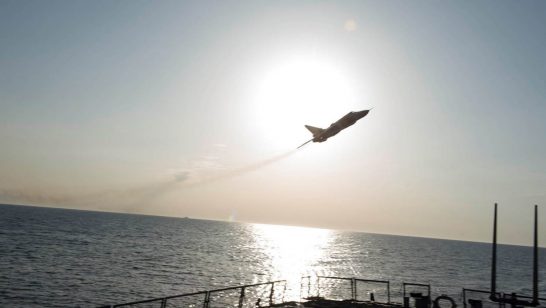
The possible Russian suspension of the US-Russia deconfliction agreement, pertaining to uncoordinated aerial activity in Syrian airspace, in response to US cruise missile strikes against the Syrian regime in April 2017 marks the latest episode in the negative spiral in Russia-west relations.
In a period encompassing challenges to key pillars of European stability, such as the Intermediate-range Nuclear Forces Treaty (INF) and OSCE’s Vienna Document on Confidence and Security Building Measures, the suspension of the only document regulating encounters between the US, its allies, and Russia over an active war zone is of dire concern to all with a stake in Euro-Atlantic security.
A Practical Necessity
The deconfliction agreement, negotiated and signed in October 2015, put in place a series of protocols designed to reduce the risk of an incidental or accidental clash between US and Russian aircraft whilst they conduct their parallel air campaigns in Syrian airspace. The agreement was rapidly extended to the rest of the 64 state US-led coalition engaging the Islamic State in Syria.
Key aspects of the protocol included rules on the physical separation of aircraft, specifically the provision that Russian and coalition aircraft should maintain a distance of three nautical miles (5.6km) horizontally or 3,000 feet (914m) vertically. Should this prove impractical, pilots should reestablish this distance within three minutes.
This was backed by a regular communication channel between a Russian-speaking US Colonel based in Qatar and their Russian equivalent in Syria. The Colonels had three scheduled calls a week, but in practice spoke daily, often multiple times. Reports suggest that this practice is still operational but it is unclear how long this will remain the case.
The final aspect of the agreement instituted a video conference between senior Pentagon officials and their Russian counterparts, held every six to eight weeks.
The deconfliction agreement is not flawless, the narrowness of the communication channel played a not inconsiderable role in the mistaken bombing of Syrian army troops by American aircraft in September 2016, but it has thus far served to prevent an incident in which Russian and coalition aircraft have mistakenly collided, or more seriously, engaged each other. As was highlighted by the shooting down of a Russian aircraft by the Turkish Air Force on the Turkey-Syria border in November 2015 this is not an idle concern.
The possible suspension of the agreement has come at a critical time. Aerial activity over Syria has continued to intensify and become ever more concentrated. Islamic State has been gradually driven back to Raqqa whilst the Syrian regime, backed by Russia, Iran, and Hezbollah, has consolidated its position and isolated remaining rebel forces in Idlib province. It is inevitable that Russian and coalition aircraft will be forced to operate in ever closer proximity, often backing opposing forces on the ground. It is thus deeply concerning that the Russian government has chosen such a moment to potentially suspend the deconfliction agreement.
There is no effective fall-back option. Agreements between Russia and leading members of the coalition on the management of air and sea incidents [1] only apply to international airspace and waters, they have no validity in the fast moving and legally opaque situation in the skies above Syria.
The Russian deployment to Syria has already put these agreements under strain. Russian naval activity in the eastern Mediterranean has led to confrontation with US formations, whilst increased Russian military activity along the maritime supply routes through which the Syrian deployment is maintained has raised concern among neighbouring states and highlighted the incomplete nature of risk-reduction mechanisms in Europe. Other structural problems persist, also apparent in Syria, such as the lack of transponders on several models of Russian military aircraft, further increasing the risk of miscalculation.
Disproportionate Response
Recently, Russia has shown itself to be pragmatic in the matter of managing incidents over Syria. Indeed, the initial negotiation of the deconfliction agreement itself at such a fraught period in US-Russia relations is an excellent example of what can be achieved on an ad-hoc basis should there be political will. Further examples abound; In January 2017 Russia and Turkey signed a bi-lateral memorandum of understanding on managing encounters, both manned and unmanned, in Syrian airspace, whilst Russia and Israel have operated a tacit deconfliction agreement since the Russian deployment to Syria began in 2015. In such circumstances recent Russian actions seem particularly poorly conceived.
Any Russian suspension of the deconfliction agreement, allegedly a symbolic response to the symbolic US cruise missile strikes, would be misguided and self-defeating. The negotiation and signing of this agreement with the US was not a concession granted to Washington by Moscow to be withdrawn at will, but a practice necessity to add a semblance of coherence and predictability to an incredibly complex situation in which Russian and American lives, and by extension a great deal more, were and continue to be at risk. In such circumstances posturing and misguided strategic communication is to be expected, but practical agreements aimed at preventing miscalculation and escalation must be allowed to continue. The Russian leadership must ensure the deconfliction agreement remains active.
Russia retains some room for manoeuvre in this regard, in which the leadership need not lose face. Importantly the announcement that the agreement was to be suspended was made by an MFA spokesman, whilst President Putin later indicated to reporters that certain communicative aspects of the agreement may remain active. Practically speaking this leaves open the possibility that the suspension of the agreement may not be enforced, or that it will be restored as a magnanimous gesture by the Kremlin. Foreign Minister Lavrov, in the press conference following his meeting with Secretary of State Tillerson, hinted that this may be the case. Lavrov noted that Putin had confirmed a readiness to return to the agreement should certain conditions be met, incuding no further strikes by the US on the Syrian armed forces.
Risk reduction mechanisms between Russia and its western neighbours are increasingly few and far between, we must hope we do not lose another.
[1] These agreements, in particular the Agreements on the Prevention of Incidents at Sea (INCSEAs) and the Agreements on the Prevention of Dangerous Military Activities (DMAs), and their operational effectiveness are discussed further in Managing Hazardous Incidents in the Euro-Atlantic Area: A New Plan of Action.
***
The opinions articulated above represent the views of the author(s), and do not necessarily reflect the position of the European Leadership Network or any of its members. The ELN’s aim is to encourage debates that will help develop Europe’s capacity to address the pressing foreign, defence, and security challenges of our time.


